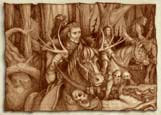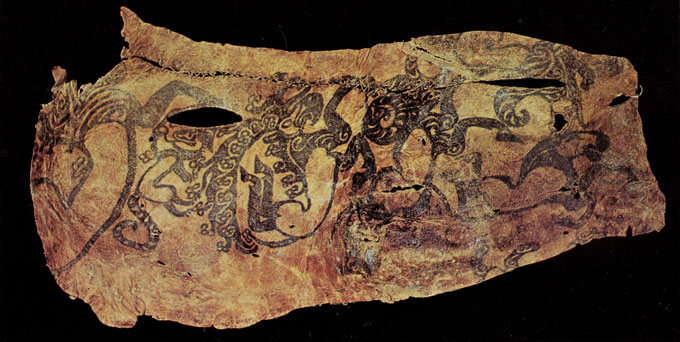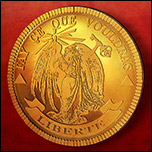
Client
: Personal Folio Piece.
Medium
: Pencil
Sketch (on
Cartridge) 20cm by
28cm :
Coloured and Enhanced in Adobe
Photoshop 2008 a.d
Notes : I've
had a few queries concerning the nature of this sketch,
Its a rendering of a Scythian belt
plaque The original is made of gold with turquoise
inlays, (width:
15.24 cm height: 9.35cm) circa 3rd century
B.C. from Altay, currently held in Czar Peter
I's (Пётр
Алексе́евич Рома́нов ) Siberian collection,
stored at the Hermitage, St. Petersburg.
The buckle portrays a yak biting a snow leopard which
in turn is shredding the tail feathers of a really
big eagle who is tearing chunks out of the yak's neck.
There may be a mirrored version of this plaque (Attached
to the other end of the belt ).
One of the Clients
I previously worked with afforded
a great deal of interaction with jewellery
making. Part of that job involves a lot of photo
retouching and rendering the appearance of gold
and other precious metals. The illustration above
comes off as a a very rosy gold and the turquoise
needs more of a matte finish.
Gold
itself, in its pure form is 24 carats, it is a soft
metal, much like lead, on Mohs scale of hardness,
gold has a hardness value of 2 to 2.5. Diamond has
a value of 10. Humanity has found that in order to
make more durable jewellery, gold needs to be mixed
with harder metals. This is the reason jewellery is
not made in pure gold, it comes in 18 carats, 14
carats and 10 carats.
|
Notes on Scythians and their Culture :
Scythian Artisans
worked with a diverse range of decorative materials such
as gold ( being the most unifying aspect of Scythian
art as mentioned above), wood, leather, finely
carved bone (retrieved from Glittering çapraks
- saddlecloths often made of goatskin),
bronze (mirrors and pole topes), iron, silver (utensils),
electrum and of course the extraordinary tattoos.

All
this from what has been extracted out of archaeological
excavations or pillaged from the Scythian
kurgans (burial mounds, for you Highlander
fans). It begs the
question has a far greater level of artwork been
lost to us through the greed and plundering
of the last 2 centuries ( as Herodotus mentions
the Scythians made everything out
of copper and gold ).
By
the fourth century BC Scythian bridle
trappings found in burials
of the northern steppe zone
beyond the Black Sea (referring
to present day Ukrainian and Russian lands approx. north of
the 48' parallel) reflected a determined adoption of the Thracian tendency
to treat decorative objects in terms of flat, incised surfaces
whereby established motifs such as Griffin (or Gryphon,
a creature said to inhabit the Scythian steppes) heads,
wings and feathering, were stylised into simplified yet easily
recognizable forms.
There are several arguments mustered in support of the attribution
of near Eastern and Greek craftsmanship
for the best and finest of Scythian metalwork.
There is, to begin, the assumption that Scythians did
not have a clue how to cast gold before they came into contact
with West Asian traditions. According to this line of reasoning,
it was the Persian love of solid gold and
the Greek sophistication in the working of
this precious metal that attracted the Scythians attention
to the possibilities inherent in solid gold or in such metal
techniques as filigree and granulation. This supposition needs
to be carefully qualified as the archaeological context is
extremely fragmented.
As prosperity increased among the Scythians through
trade with the Greeks, their nomadic lifestyle
waned as more and more of the tribes settled down to a more
rural existence. Permanent settlements began to spring up with
greater frequency along the archeological record, such as the
Bilske Horodyshche, a
dig in
the Poltava
Region of the Ukraine near
Belsk, that
gave up an ancient metropolis (1000 times larger
than Troy) believed
by Boris
Shramko to be Gelonus,
the Scythian
capital (discussed
by Herodotus), craft workshops and Greek pottery
captured the attention of those excavating the immense
ruin. Exquisite Felt appliqué wall
hangings survive within the archaic catacombs
at Pazryzk displaying
fine artwork acknowledging their Great Goddess or exhibiting
the stylised actions of Scythia's distinct anthropomorphic
beasts. Further decorations demonstrate well conceived geometric
motifs that predate the celts beautiful designs. Archaeologists
have also uncovered felt rugs, well crafted tools and domestic
utensils. Clothing uncovered by archaeologists has also been
well made many trimmed by embroidery and appliqué designs.
Wealthy people wore clothes covered by gold embossed plaques.
Animalia appears to
be the primary subject matter among Scythian jewellers.
From what we have retrieved from the earth focuses on stags,
mountain lions, predatory birds, horses, bears, wolves and
what has been deemed by the intelligentsia as 'mythical'
beasts, for example Gryphons (γρυψ)
: widely depicted throughout ancient Greece*,
mostly on coins or as paintings or sculptures to impart good
luck. The earliest depictions come out of Crete, where Gryphons
were usually shown as royal animals and guardians of throne
rooms. Again the intelligentsia postulate that The Scythians used
petrified bones found in and about their steppes as proof of
the existence of Gryphons 'attributing
a level of gullabilty to the ancients that appears common
among the scientific communities meme'.
It has been suggested that these
"Gryphon bones" were Protoceratops fossils (predecessor
of the more familiar horned dinosaurs such as Triceratops),
which are common in that part of the world.
The vigour of stylizations
shown in the golden figures of stags in their reclining poses
is astonishing, These were often the central ornaments
for shields carried by fighters. In the most notable of these
figures, stags are displayed with legs tucked beneath its body,
head upright and muscles tight to give an impression of movement
or life.
Archaeology
:
The earliest archaeological discoveries in southern Siberia
date from the beginning of the 18th century. Nicolaas Cornelius
Witsen (dutch embassy: Moscow) received 2 consignments of objects
in 1714 and 1716 consisting of forty gold articles, including
neck rings (grivny) of the finest workmanship, belt plaques
and other ornaments adorned with the now distinctive animal
motifs. Witsen's collection survives today only as fine sketches
within the pages of his book Nord en Oost Tartarie. Upon
Witsen's death the artifacts were sold at auction and melted
down for their base pecuniary value. During the same time period,
Nikita Demidov, presented the empress Yekaterina
(Catherine) with "precious gold objects from
Siberian tombs" These
works (as well as over 100 pieces relayed by Prince Gagarin,
the then governor of Siberia) formed the foundation of the
collection held by the Hermitage
Museum in Saint
Petersburg. Catherine the Great was
so impressed from the material recovered from the kurgans that
she ordered a systematic study be made of the works. Reports
of local officers began to contain reference to the discovery
of ancient objects and the wholesale ransacking of kurgans
by grave robbers and brigands.
One of the first sites
discovered by modern archaeologists were the kurgans Pazyryk, Ulagan district
of the Altay Republic (Алтай
Республика),
south of Novosibirsk. The name Pazyryk culture
was Attached to the finds, five large burial mounds and several
smaller ones between 1925 and 1949 opened in 1947 by a Russian
archeologist, Sergei Rudenko; Pazyryk is
in the Altay Mountains of southern Siberia.
The kurgans contained items for use in the afterlife. The
famous Pazyryk carpet discovered is the
oldest surviving wool pile oriental rug.
A kurgan near the village of Ryzhanovka in
the Ukraine, 75 miles south of Kyiv,
found in the 1990's has revealed one of the few unlooted tombs
of a Scythian chieftain, who was ruling in
the forest-steppe area of the
western fringe of Scythian lands. There at a late date
in Scythian culture (ca. 250 - 225 BC), a recently
nomadic aristocratic class was gradually adopting the agricultural
life-style of their subjects. Many items of jewellery were
also found in the kurgan.
A discovery made by Russian
and German archaeologists in 2001 near Kyzyl,
the capital of the Russian republic of Tuva in Siberia is
the earliest of its kind and predates the influence of Greek civilisation.
Archaeologists discovered almost 5,000 decorative gold pieces
including earrings, pendants and beads. The pieces contain
representations of many local animals from the period including
panthers, lions, bears and deer.
---------------------------------------------------------------------------------------------------------------------------------------
*Ancient
Greeks believed in the Gigantes (Γίγαντες)—Titans,
heroes and semi-human creatures far larger
than what would be now be considered the
norm. Atlas, the Cyclops, and the Titans
were among them, but possibly the greatest
of them all was Pelops. Poets envisioned
him as a handsome interloper from the east,
with a shoulder blade made of ivory (after
having a vegetarian Goddess inadvertently
eat his shoulder). After winning a rigged
chariot race, Pelops was said to have founded
the Olympic games as a way to honour the
gods for his victory. He also reigned over
Greece's southern peninsula—the Peloponnese,
whose name means "Pelops's island."
At the peninsula's northwest corner stood Olympia,
a religious complex that was the site of the Olympic games
and of a shrine that claimed a relic of the mighty giant himself—his
massive, ivory-white shoulder blade. During the Trojan War,
the elephantine relic was reportedly shipped to the walls of Troy,
as a talisman to bring the Greeks victory.
Greek writers, from the fifth-century B.C.
historian Herodotus to
the second-century A.D. travel writer Pausanias,
chronicled sightings of the remains of giants. Immense, disarticulated
skeletons appeared along unstable shorelines, and huge, jumbled
bones poked from weathered hills and cliffs.
Today most if not all 'scholars' shelve stories of giant
bones under fiction ( because ancient writers were
stupid, and didn't have the proper institutions to tell
them what to think and pretty much just pulled ideas out
of their arses- creative thought is bad).
But Adrienne Mayor, a folklorist and historian
of early science, takes the Greeks at their word. "Since
the 19th century," Mayor says, "modern paleontologists
have discovered rich bone beds of giant, extinct mammals in
the same places the ancient Greeks reported finding the bones
of heroes and giants." She thinks what the Greeks actually
found were isolated fossil bones of creatures like the southern
mammoth. With no other way to explain the bones, the Greeks,
being ignorant (as all ancient races would have to have
been), conceived them as the porous calcified remnants
of giant god-like characters.
In theory Mammoth bones would have dwarfed
any living creature native to the lands of
the ancient Greeks. The fossil beds that
studded the Greek and larger Mediterranean
world included those of Mammoths, Elephants,
and other animals that had lived tens of
thousands of years before the Greeks. More
fragile bones, such as skulls, often didn't
survive. But denser remains—shoulder
blades and thighbones, which bear a resemblance to human bones—did.
"They also found fossil ivory tusks from extinct mammoths
in the ground," Mayor says, "and they (must have)
assumed the ivory was produced by the earth, like gems and
minerals. In fact, the ancient Greek word for ivory, elephas,
was the name they gave to elephants once they did encounter
them." That first encounter probably didn't happen until
the fourth century B.C., when Alexander the Great and his army
advanced on Babylon and were met by a phalanx of Persian war
elephants.
By that time, though, the myths of superhumans
and giants were well established in the Greek
mind. Could some of these characters have
been inspired by finds of enormous fossil
bones that couldn't otherwise be explained?
Or did the myths come first—and
when confronted with the bones, did the Greeks imagine them
reassembled as the villains and heroes of the larger-than-life
mythic world?
Personal
Library :
Recommended Reading : ( links to Amazon.com
if available)
The
Art of the Scythians: The Interpretation of Cultures at the
Edge of the Hellenic World (Handbook of Oriental Studies,
Vol 2) (Hardcover) Esther
Jacobson(-Tepfer) Leiden: E. J. Brill. 1995. (Hardcover) Esther
Jacobson(-Tepfer) Leiden: E. J. Brill. 1995.
The
Oxford Illustrated Prehistory of Europe (Hardcover)
Oxford Barry
Cunliffe (Editor) University Press, USA (May 12,
1994) (Hardcover)
Oxford Barry
Cunliffe (Editor) University Press, USA (May 12,
1994)
The
Story of Archaeology: The 100 Great Archaeological
Discoveries Paul
G. Bahn (editor) Phoenix (an Imprint of The Orion Publishing
Group); New Ed edition (1997) Paul
G. Bahn (editor) Phoenix (an Imprint of The Orion Publishing
Group); New Ed edition (1997)
The
Scythians (Ancient
peoples and places. 2) (Hardcover)
Tamara Talbot Rice: Thames & Hudson. 1957. (Ancient
peoples and places. 2) (Hardcover)
Tamara Talbot Rice: Thames & Hudson. 1957.
The History of Herodotus.
Trans : George Rawlinson: (Hardcover)
University of Chicago 1952.
Herodotus:
The Histories John
M. Marincola (Editor), Aubrey De Selincourt (Translator)
Penguin Classics (September 1, 1996)
The
Ancient Civilization of South Siberia (Hardcover)
Mikhail Gryaznov : Barrie &
Rockliff, London 1969. (Hardcover)
Mikhail Gryaznov : Barrie &
Rockliff, London 1969.
The
First Horsemen :
The Emergence of Man (Hardcover) Frank Tippet : Time-Life
Books 1974. :
The Emergence of Man (Hardcover) Frank Tippet : Time-Life
Books 1974.
The World's Last Mysteries Reader's Digest Association (January 1978)
Reader's Digest Association (January 1978)
A
History of Russia Nicholas
V. Riasanovsky (Author) Oxford University Press, USA; 5 edition
(March 11, 1993) Nicholas
V. Riasanovsky (Author) Oxford University Press, USA; 5 edition
(March 11, 1993)
The
Archaeology of Ancient Turkey (Bodley Head Archaeology) (Hardcover)
James Mellaart (Author) (April 1978) (Hardcover)
James Mellaart (Author) (April 1978)
Russian
history atlas (Hardcover) Martin
Gilbert (Author) Weidenfeld & Nicolson (1972)
Additional
Reading:
http://www.cannabisculture.com/backissues/cc02/scythians.html
Note to self : Do
not lend books to people , they just don't return
the good ones. |


